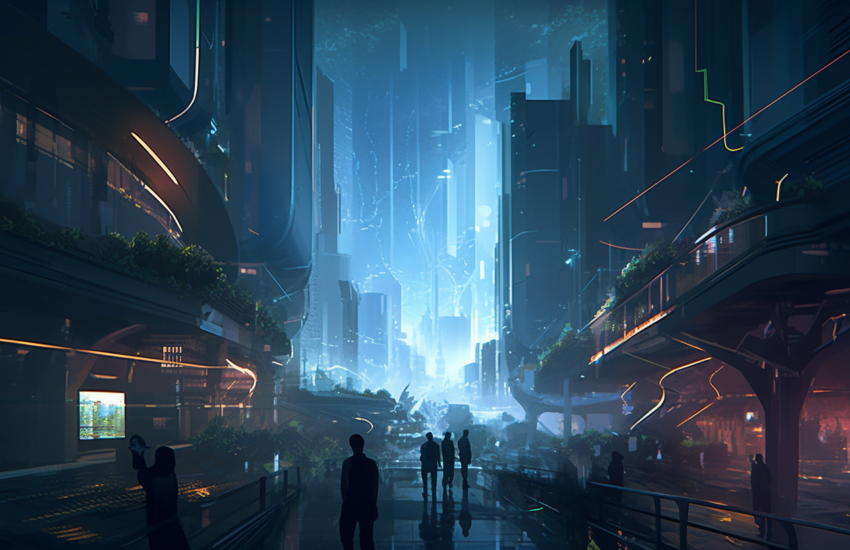AI has taken the world by storm. New AI startups and solutions are emerging almost daily to revolutionize existing industries. The democratization of AI through open source models and API availability has further catalyzed this wave of new AI solutions. Thanks to its convenient automation and generative capabilities, AI is offering futuristic experiences, today.
AI models are becoming increasingly intelligent as more startups and consumers provide user data. As AI continues to improve and advance exponentially, the question remains: what will AI look like in the future?
AI can be trained to follow almost any pattern, including human interactions. This fact allows us to understand why some industries have adopted AI faster than others. In our research, we’ve outlined the biggest industries that AI has the potential to completely revolutionize.
AI in the Production Cycle
AI already exists in fast fashion, made popular by fashion startup SHEIN, by offering necessary insights and optimization to the overall retail production cycle. SHEIN’s use of AI allows for rapid back-and-forth communication between influencers, prototyping and marketing. It delivers insights and trend analyses that allows SHEIN to determine and produce fashion concepts significantly faster than other competitors.
As AI continues to understand the production cycle, optimizations for cost and sustainability will be completely automated with real time data, immediately influencing production and material usage.
Through the use of Stable Diffusion and other image generation models, AI will offer rapid prototyping, blueprints, and proof of concepts. As image generation models improve, they will be uniquely tailored to brands’ style and values. Combined with social listening platforms that provide real time data on current social trends, these models will provide suggested materials, designs, and blueprints – all through a single text prompt.
Additionally, image generation models have the potential to transform existing marketing and advertising methods. Branded AI generative models will offer instant, curated product shoots and complete synthetic supermodels that can reflect any demographic.
AI in the Supply Chain and Manufacturing
As computer vision and material costs improve, robotics will see substantial improvements and widespread integration in both practical applications and complex tasks.
Robotics and AI are already transforming warehouses and the supply chain through product scanning and verification, demand projections, and optimized product shelving. Amazon, for example, uses AI in warehousing by processing 1.6 million packages a day. Without the prolific use of AI and robotics to optimize warehouse operations and the supply chain, Amazon would not be the success it is today.
AI and robotics will not only further improve the supply chain, but will also see significant strides in manufacturing. AI will eventually be able to prototype and manufacture a retail store, warehouse, commercial office, or residential facility completely from scratch. Generative models will optimize common foot traffic for different parts of a store.
As previously mentioned, AI models will understand brand identity and design, and the architectural and interior design of retail stores will be reflected in the generated prototype. AI will also determine the optimal materials and raw parts needed for construction, while maximizing structural integrity and minimizing cost. Combined with manufacturing robotics, this entire process will be completely automated.
AI for Customer Support and Loyalty
The use of Customer Data Platforms (CDPs) to provide real-time information about customers is not a new concept. Nearly all retailers and brands use a form of CDP to enhance the customer experience through tailored advertisements and loyalty rewards. However, many customer data platforms require manual login to a computer. Having to manually search for a customer is not conducive to the seamless customer experience that many retailers and consumers desire.
AI facial recognition serves as the solution to this problem. Many stores will eventually use existing security cameras to ‘check-in’ customers. Then, customer profiles will be immediately fed to sales associates through AR glasses or tablets for immediate application to the customer experience. Associates will know exactly what to suggest to meet customer preferences, and personalized rewards will be offered instantly.
AI will understand the store’s specific goals of revenue, margins, or product throughput, and can optimize suggestions to account for such goals. Checkout will also be seamless, as a customer will have their profile linked to a credit card, and can simply walk out of the store when concluding their shopping.
AI in the Home
Already finding its place in our homes through smart home devices, voice-driven assistants, or automated thermostats, AI has the potential to be embedded everywhere.
Many traditional facets of a home will soon have integrated AI such as:
- Smart windows with generated art
- Smart tables with built-in tablet and holographic capabilities
- Coffee makers that provide personalized coffee based on detected mood
- Refrigerators that use computer vision to recommend recipes and predict spoilage
AI assistants will live at home with you and provide tailored recommendations, news, and current trends, and as brain chips become safer and more widespread, AI will also be integrated within, providing real time analyses on environmental stimuli and mental health.
So what?
We are in the midst of an AI revolution.
Any set of cause-and-effect relationships can be modeled and optimized by an AI, invariably removing human error in many of these calculations. AI is inevitable and we must learn to work alongside it. AI will automate processes that we find tedious, so we can maximize our time with the ones we enjoy.
AI has the potential to completely upheave and transform all of our lives. It is easy to diminish modern AI as a fad, but the fact of the matter remains: AI will exponentially improve.

